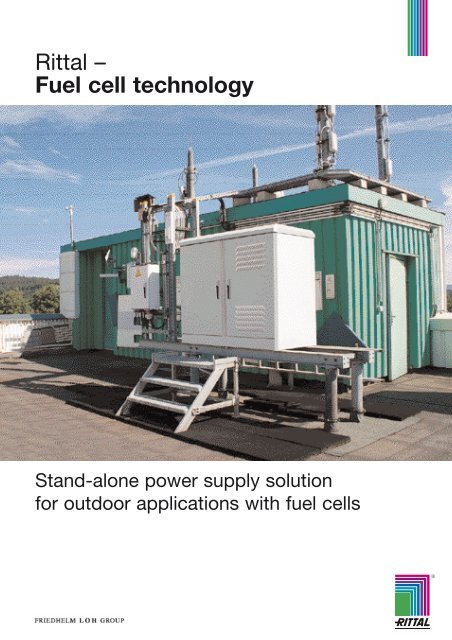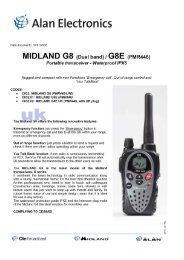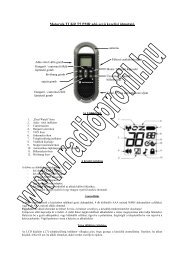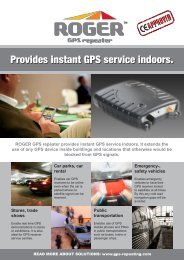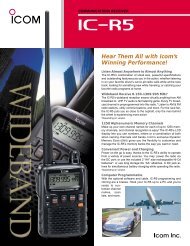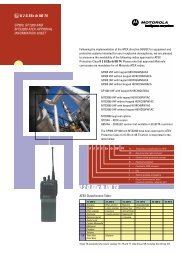Fuel cells for outdoor applications
Fuel cells for outdoor applications
Fuel cells for outdoor applications
You also want an ePaper? Increase the reach of your titles
YUMPU automatically turns print PDFs into web optimized ePapers that Google loves.
Rittal –<br />
<strong>Fuel</strong> cell technology<br />
Stand-alone power supply solution<br />
<strong>for</strong> <strong>outdoor</strong> <strong>applications</strong> with fuel <strong>cells</strong>
2<br />
<strong>Fuel</strong> <strong>cells</strong> <strong>for</strong> <strong>outdoor</strong> <strong>applications</strong> –<br />
stand-alone and powerful<br />
Reliable redundancies in the <strong>for</strong>m of emergency power supply systems must be established in critical <strong>applications</strong> demanding<br />
high-availability. From the field of cellular phones via telematics and remote measuring stations through to the primary energy<br />
source <strong>for</strong> in<strong>for</strong>mation kiosk systems and <strong>applications</strong> at open-air events – <strong>for</strong> all these the fuel cell represents the convincing<br />
“energy supplier”. Here Rittal with its expertise and know-how in the fields of <strong>outdoor</strong> building technology, climate control and<br />
system integration can supply complete solutions.<br />
Outdoor <strong>applications</strong>:<br />
• The Rittal fuel cell in the Toptec CR <strong>outdoor</strong> enclosure is a full-function emergency power supply unit <strong>for</strong> <strong>outdoor</strong> use that is<br />
combined with the primary supply systems of well-known manufacturers. The Rittal solution has clear advantages over batterybuffered<br />
systems in respect of service life, permissible temperature variations, back-up times and TCO (Total Cost of Ownership).<br />
• The ITS Out-Line Pro terminal as a point-of-in<strong>for</strong>mation kiosk is completely self-sufficient; no energy-supplying network is<br />
required. The hydrogen supply system is integrated directly in the terminal. The innovative re<strong>for</strong>mer technology converts<br />
methanol into hydrogen and ensures that the unit can be operated <strong>for</strong> long periods without maintenance.<br />
How a fuel cell works<br />
<strong>Fuel</strong> <strong>cells</strong> convert the chemical energy<br />
arising from the reaction between<br />
hydrogen (H 2) and oxygen (O 2)<br />
directly into electrical energy, water<br />
and heat.<br />
• A fuel cell essentially consists of<br />
two electrodes separated from<br />
each other by an electrolyte.<br />
• At one electrode, the hydrogen is<br />
separated into positively charged<br />
protons and negatively charged<br />
electrons.<br />
• At the oxygen electrode, oxygen<br />
molecules (O 2) are dissociated<br />
Reliable emergency power supply<br />
system <strong>for</strong> <strong>outdoor</strong> <strong>applications</strong><br />
The emergency power supply system<br />
is fully integrated into the Toptec CR<br />
climate-controlled enclosure and may be<br />
supplied with hydrogen directly at the<br />
place of installation. The oxygen required<br />
by the system is obtained from the filtered<br />
ambient air. The broader temperature<br />
range of the fuel cell stack compared<br />
with conventional, battery-buffered backup<br />
systems is a major advantage, since<br />
batteries require constant temperatures<br />
inside the enclosure.<br />
(separated) and are able to absorb<br />
electrons at the electrode.<br />
• The hydrogen ions pass through<br />
the electrolyte to the positive<br />
electrode where they react with<br />
the oxygen ions to <strong>for</strong>m water.<br />
• The two electrodes are connected<br />
to one another via an external load<br />
so that an electric current flows.<br />
The flow of current is supplied<br />
directly by converting a significant<br />
portion of the chemical energy<br />
from hydrogen and oxygen into<br />
electrical energy.<br />
Other benefits include:<br />
• Freely scalable autonomy, by adapting<br />
the volume of hydrogen stored at the<br />
site. In this way, individual back-up<br />
times may be achieved very easily <strong>for</strong><br />
each installation site.<br />
• A substantially longer service life than<br />
batteries – the total service life of the<br />
plant in this mode of operation is<br />
approximately 10 years.<br />
• Minimal servicing and maintenance<br />
requirements <strong>for</strong> the emergency backup<br />
supply.<br />
The combined benefits of the Rittal fuel<br />
cell compared with battery buffered<br />
back-up power supplies translate into a<br />
reduced total cost of ownership.
Toptec CR<br />
with fuel cell as emergency power supply unit<br />
Application:<br />
Outdoor emergency power supply unit, e.g. <strong>for</strong> cellular phone<br />
base stations<br />
Material:<br />
Enclosure frame: stainless steel 1.4301 (AISI 304)<br />
Door, side panels, air-conditioning hood, roof: aluminium AlMg3,<br />
powder coated in RAL 7035<br />
Supply includes:<br />
Ready-to-connect fuel cell system including climate control.<br />
The hydrogen supply is not included.<br />
On request:<br />
• Cascadable, up to 3 systems<br />
• Non-standard input / output voltage<br />
• Use as primary supply unit (not <strong>for</strong> continuous 24 h operation)<br />
• Re<strong>for</strong>mer system, e.g. feeding-in of methanol instead of<br />
hydrogen<br />
• Housing <strong>for</strong> gas cylinders<br />
• Further protocols: S-bus, Profibus, Modbus, MPI, EIB, LON,<br />
Bac Net, GENIbus<br />
Width (B) mm 694 694<br />
Height (H) mm 1403 1403<br />
Depth (T1) mm 675 675<br />
Overall depth (T2) mm 992 992<br />
Weight (kg) 175 182<br />
Model No. CS 9782.030 9782.050<br />
<strong>Fuel</strong> cell<br />
Output scalable up to 3000 W 5000 W<br />
Rated voltage, input 230 V, 50/60 Hz 230 V, 50/60 Hz<br />
Voltage, output – 48 V DC (– 46 V DC to – 54 V DC) – 48 V DC (– 46 V DC to – 54 V DC)<br />
Max. power failure 0.005 seconds 0.005 seconds<br />
Noise (at full load and approx. 60 dB (A) approx. 60 dB (A)<br />
high ambient temperature)<br />
Hydrogen supply<br />
Gas type Hydrogen, purity at least 3.5 Hydrogen, purity at least 3.5<br />
Recommended supply 50 litre or 10 litre bottles, 200 bar 50 litre or 10 litre bottles, 200 bar<br />
Consumption at full load 45 slpm (standard litres per minute) 75 slpm (standard litres per minute)<br />
Freely scalable via manifolds, 50 l, 200 bar hydrogen Freely scalable via manifolds, 50 l, 200 bar hydrogen<br />
Stored energy time produces approx. 10 kW output, i.e. with 3 kW produces approx. 10 kW output, i.e. with 5 kW<br />
full load, this means an autonomy of 3.5 hours full load, this means an autonomy of 2 hours<br />
Replacement of gas bottles Whilst the system is operational (hot swap) Whilst the system is operational (hot swap)<br />
Ambient conditions<br />
Temperature range – 33 °C to + 50 °C – 33 °C to + 50 °C<br />
Relative humidity 0 % to 95 %, no condensation 0 % to 95 %, no condensation<br />
Height above mean sea level 0 to 2000 m 0 to 2000 m<br />
Monitoring<br />
Interface Ethernet-IP Ethernet-IP<br />
3
ITS Out-Line Pro<br />
with fuel cell as primary supply unit<br />
T2<br />
T1<br />
The kiosk can be put to use anywhere<br />
where visitors from around the<br />
world must be provided with in<strong>for</strong>mation,<br />
e.g. at exhibitions, festivals and<br />
sporting events. With the fuel cell<br />
power supply you need absolutely no<br />
link to the mains. Thus the POI kiosk<br />
can be put into operation in the very<br />
shortest time. The complete unit<br />
including the fuel supply is integrated<br />
in the <strong>outdoor</strong> enclosure.<br />
Fax hotline +49(0)2772 505-70101<br />
B<br />
Methanol is converted into hydrogen<br />
with the aid of the re<strong>for</strong>mer technology<br />
whereby the high amount of hydrogen<br />
contained in the methanol<br />
permits long operating times. Thanks<br />
to its double-wall design, the <strong>outdoor</strong><br />
enclosure – which is both robust and<br />
attractive – offers further advantages<br />
such as protection against vandalism,<br />
noise-reduced PC systems and<br />
a wide permissible ambient temperature<br />
range.<br />
Application Primary supply<br />
ITS Out-Line Pro<br />
Enclosure (WxHxD) 650 x 2000 x 400 mm<br />
1000 x 2400 x 1000 mm, including roof<br />
Material Aluminium, powder-coated in<br />
RAL 9007 or RAL 7035<br />
Piping: stainless steel<br />
Interior installation ITS PC system “silent” or “Pro II”,<br />
touch-screen, stainless steel or<br />
membrane keyboard<br />
<strong>Fuel</strong> cell<br />
Output 250 W<br />
Rated voltage<br />
(output) – 12 V DC<br />
Supply<br />
Re<strong>for</strong>mer Methanol/water mix (65% / 35%)<br />
Permissible ambient conditions<br />
Temperature range – 33 °C to + 50 °C<br />
Rel. air humidity 0 % to 95 %, no condensation<br />
Please send me: IT News 2006 Catalogue 31<br />
Name, Surname<br />
Company<br />
Department<br />
Address<br />
Telephone/Fax<br />
E-mail<br />
Date, signature<br />
Rittal GmbH & Co. KG • Postfach 1662 • D-35726 Herborn<br />
Telephone: +49(0)2772 505-0 • Telefax: +49(0)2772 505-2319 • eMail: info@rittal.de • www.rittal.com<br />
H<br />
Switch to perfection<br />
03/06 · E660


